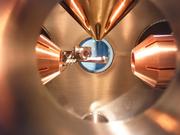Home > Press > Microscopic structure of quantum gases made visible
 |
| Inside the high-resolution scanning electron microscope Photo: QUANTUM, Mainz University |
Abstract:
Physicists of Mainz University have first managed to plot the distribution of individual gases in the Bose-Einstein condensate / Published in Nature Physics Scientists at the Johannes Gutenberg University Mainz have, for the first time, succeeded in rendering the spatial distribution of individual atoms in a Bose-Einstein condensate visible. Bose-Einstein condensates are small, ultracold gas clouds which, due to their low temperatures, can no longer be described in terms of traditional physics but must be described using the laws of quantum mechanics. The first Bose-Einstein condensates were generated in 1995 by Eric A. Cornell, Carl E. Wieman and Wolfgang Ketterle, who received the Nobel Prize in Physics for their work only six years later. Since then, these unique gas clouds, the coldest objects humans ever created, have become a global research object.
Microscopic structure of quantum gases made visible
Germany | Posted on October 21st, 2008Physicists working with Dr Herwig Ott in the study group for quantum, atomic and neutron physics (QUANTUM) at Mainz University have now developed a new tech-nology that can be used to plot the individual atoms in a Bose-Einstein condensate. In addition, the spatial resolution achieved during plotting far exceeds any previous methods used. The research results of the Emmy Noether Independent Junior Research Group, sponsored by the German Research Foundation (DFG), were published in the professional journal Nature Physics under the title of "High-resolution scanning electron microscopy of an ultracold quantum gas".
This breakthrough was possible due to the use of a high-resolution scanning elec-tron microscope that makes use of a very fine electron beam to scan the ultracold atomic cloud, thus rendering even the smallest structures visible. "The transfer of this technology to ultracold gases was a technical risk," reports Dr Herwig Ott, head of the Emmy Noether Junior Research Group, "as two different techniques had to be combined." Moreover, atoms and molecules move completely freely and ran-domly in gases unlike they do in solids. Another advantage of this highly advanced microscopy process is the better spatial resolution compared with optical processes where the resolution capacity is limited by the wavelength of the light used. "With a resolution of 150 nm, we are able to view these quantum objects with an accuracy that is 10 times higher than has been possible to date," explains Ott.
As electron microscopy made previously unknown parts of our world visible to the viewer, so the technology developed in Mainz has opened up unique possibilities for investigating the microscopic structure of quantum gases. The physicists in Mainz have already reached their first major milestone: They managed to make the structure of a so-called optical lattice visible. Optical lattices are interference patterns comprised of laser beams, which are shone onto the atomic cloud and force their periodic structure onto it. This results in the creation of crystal-like formations. The interesting aspect is that the movement of the atoms in an optical lattice within a quantum gas is similar to the behavior of electrons in solid bodies. Quantum gases are thus able to simulate the physical properties of solid bodies and can therefore also contribute to answering outstanding questions in solid-state physics.
####
For more information, please click here
Contacts:
QUANTUM
Staudingerweg 7
D 55128 Mainz
+49-6131-39-22279 (C. Best)
+49-6131-39-20175 (E. Stuck-Kerth)
Fax: +49-6131-39-25179
Copyright © Johannes Gutenberg University Mainz
If you have a comment, please Contact us.Issuers of news releases, not 7th Wave, Inc. or Nanotechnology Now, are solely responsible for the accuracy of the content.
| Related News Press |
News and information
![]() Researchers develop molecular qubits that communicate at telecom frequencies October 3rd, 2025
Researchers develop molecular qubits that communicate at telecom frequencies October 3rd, 2025
![]() Next-generation quantum communication October 3rd, 2025
Next-generation quantum communication October 3rd, 2025
![]() "Nanoreactor" cage uses visible light for catalytic and ultra-selective cross-cycloadditions October 3rd, 2025
"Nanoreactor" cage uses visible light for catalytic and ultra-selective cross-cycloadditions October 3rd, 2025
Discoveries
![]() Researchers develop molecular qubits that communicate at telecom frequencies October 3rd, 2025
Researchers develop molecular qubits that communicate at telecom frequencies October 3rd, 2025
![]() Next-generation quantum communication October 3rd, 2025
Next-generation quantum communication October 3rd, 2025
![]() "Nanoreactor" cage uses visible light for catalytic and ultra-selective cross-cycloadditions October 3rd, 2025
"Nanoreactor" cage uses visible light for catalytic and ultra-selective cross-cycloadditions October 3rd, 2025
Announcements
![]() Rice membrane extracts lithium from brines with greater speed, less waste October 3rd, 2025
Rice membrane extracts lithium from brines with greater speed, less waste October 3rd, 2025
![]() Researchers develop molecular qubits that communicate at telecom frequencies October 3rd, 2025
Researchers develop molecular qubits that communicate at telecom frequencies October 3rd, 2025
![]() Next-generation quantum communication October 3rd, 2025
Next-generation quantum communication October 3rd, 2025
![]() "Nanoreactor" cage uses visible light for catalytic and ultra-selective cross-cycloadditions October 3rd, 2025
"Nanoreactor" cage uses visible light for catalytic and ultra-selective cross-cycloadditions October 3rd, 2025
Quantum nanoscience
![]() ICFO researchers overcome long-standing bottleneck in single photon detection with twisted 2D materials August 8th, 2025
ICFO researchers overcome long-standing bottleneck in single photon detection with twisted 2D materials August 8th, 2025
![]() Programmable electron-induced color router array May 14th, 2025
Programmable electron-induced color router array May 14th, 2025
|
|
||
|
|
||
| The latest news from around the world, FREE | ||
|
|
||
|
|
||
| Premium Products | ||
|
|
||
|
Only the news you want to read!
Learn More |
||
|
|
||
|
Full-service, expert consulting
Learn More |
||
|
|
||








